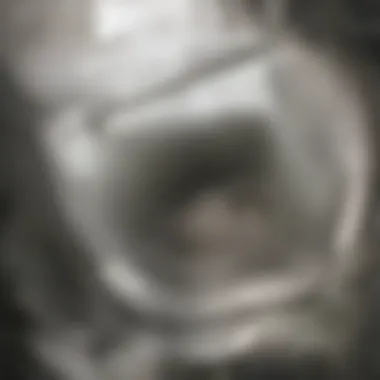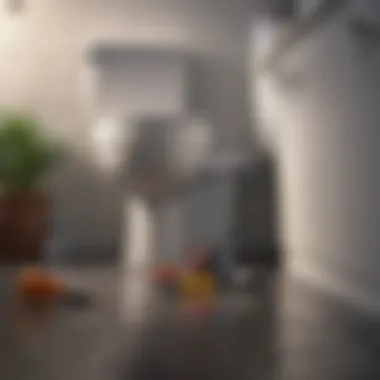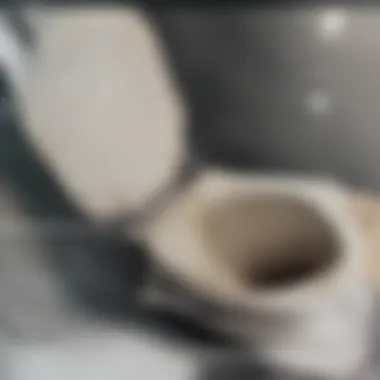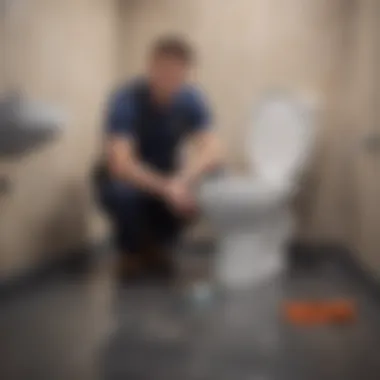Addressing a Clogged Toilet: A Step-by-Step Guide


Intro
Clogged toilets can be a significant inconvenience for homeowners. Understanding the nuances of this common issue is essential for effective resolution. Identifying the causes is the first step in troubleshooting, which can save time and frustration. Utilizing the right tools can further enhance your problem-solving efforts.
Often, clogs occur due to the accumulation of materials, improper use, or plumbing issues. An informed homeowner can manage many situations, but some instances do require professional help. Therefore, this guide will encompass not only primary strategies for addressing clogs but also preventive measures to avoid them in the future.
In this guide, we will explore:
- Identifying Causes of Clogs: Recognizing why toilets get clogged.
- Initial Troubleshooting: Steps to check before attempting a fix.
- Necessary Tools: Key implements to have on hand.
- Advanced Intervention: Techniques for more stubborn clogs.
- Preventive Measures: How to avoid future blockages.
- When to Call a Professional: Knowing your limits.
By following these guidelines, homeowners can confidently tackle toilet clogs and improve overall plumbing maintenance.
Understanding Toilet Clogs
Understanding toilet clogs is essential because it lays the groundwork for effective problem-solving. A clogged toilet can disrupt daily life and create unpleasant odors. By grasping the underlying causes and recognizing the symptoms, homeowners can act swiftly to rectify the issue.
Common Causes of Toilet Clogs
Toilets can easily become clogged due to various reasons. Some of the most common culprits include:
- Excessive Toilet Paper: Overusing toilet paper can quickly block the pipes, especially if the toilet is not designed to handle large quantities.
- Foreign Objects: Many items are not meant to be flushed, such as toys, sanitary products, or wipes. These can cause significant obstructions.
- Tree Roots: In older homes, tree roots can invade sewer lines, leading to clogs that cannot be fixed without professional help.
- Low Flow Toilets: While designed to conserve water, these toilets sometimes lack the power needed to flush waste effectively.
Recognizing the reasons behind a clog can save time and prevent damage to plumbing systems.
Symptoms of a Clogged Toilet
Identifying a clogged toilet early can prevent further complications. Common symptoms include:
- Slow Drainage: If water takes a long time to go down after flushing, a clog may be forming.
- Gurgling Sounds: Unusual sounds from the toilet or nearby drains indicate air trapped in the pipes.
- Overflowing Toilet: This is a clear sign of a serious clog.
- Water Backup: If water comes back up into the bowl, immediate action is needed.
Being familiar with these symptoms allows homeowners to respond proactively to potential issues, avoiding costly repairs in the future.
Understanding the signs and causes of toilet clogs is crucial for maintaining a functional and efficient home plumbing system.
Initial Assessment
When dealing with a clogged toilet, the first crucial step is the initial assessment. This phase allows homeowners to evaluate the situation before taking any immediate action. Understanding the nature of the clog is essential to choosing the right method for resolution. An accurate assessment can save time, prevent further damage, and ultimately reduce frustration.
Identifying the Severity of the Clog
Recognizing how severe the clog is can guide your troubleshooting strategy. Toilets can experience minor blockages that may resolve easily with a plunger. However, other clogs might require more extensive measures.
Here are signs to consider:
- Water levels in the toilet bowl: If the water rises close to the rim after a flush but then slowly goes down, this points to a partial blockage.
- Multiple flush attempts: Needing to flush several times to clear waste could indicate a significant issue in the drain line.
- Foul odors: Persistent unpleasant smells may suggest deeper problems within the plumbing system.
- Backflow in fixtures: If water backs up in other fixtures such as sinks or bathtubs, the clog may be more extensive, possibly located further down the sewer line.


Understanding these warning signs enables quicker and more effective responses to the problem.
Determining Possible Solutions
After identifying the severity, one can approach possible solutions. The nature of the clog largely dictates the method of resolution.
Consider the following:
- For minor clogs: A standard plunger or flange plunger often suffices. These tools create pressure to dislodge the obstruction.
- For moderate blockages: Use a toilet auger. This tool can reach deeper into the toilet's plumbing, effectively removing stubborn clogs without damaging the pipe.
- For severe problems: It may be necessary to employ chemical drain cleaners. However, these should be used with caution. Alternatively, removing the toilet might be the best course of action, especially if the blockage refuses to budge.
Essential Tools for Clog Resolution
Confronting a clogged toilet requires more than just a bit of determination. It necessitates the right tools to ensure that the situation is resolved effectively without causing further damage or creating additional hassles. Choosing the correct tool is important since it can save time and remove frustration. Essential tools for clog resolution include a plunger, an auger, and sometimes chemical drain cleaners. Understanding how to use these tools and when to apply them can make a significant difference.
Plunger: Types and Techniques
Standard Plunger
The standard plunger is widely recognized for its simplicity and effectiveness. It features a rubber cup and a wooden or plastic handle. The key characteristic of the standard plunger is its ability to create suction, which is crucial for dislodging soft clogs. This makes it a popular choice for many homeowners because it is easy to use and often yields quick results.
A notable advantage of the standard plunger is its low cost and accessibility. Most people have one at home, making it the first line of defense against toilet clogs. However, it does have limitations. It is less effective against hard or stubborn clogs that are deeper within the plumbing. The suction may not be sufficient in such cases.
Flange Plunger
The flange plunger is specifically designed for toilets, featuring a cup with an additional flange that extends from the bottom. This unique feature allows it to create a more effective seal in toilet bowls compared to the standard plunger. This quality makes the flange plunger a beneficial choice when dealing with toilet clogs, as it enhances the power of suction.
One of the main advantages of the flange plunger is its ability to effectively tackle tough blockages that might resist a standard plunger. However, it demands a bit more skill to use correctly, ensuring that the flange fits snugly within the toilet bowl. Without proper technique, the flange plunger can be less effective.
Auger: When and How to Use
An auger, also known as a toilet snake, is another essential tool for resolving toilet clogs. It consists of a long, flexible metal cable with a coil at the end. The key feature of an auger is its ability to break up or retrieve more stubborn blockages that lie deeper in the plumbing system. This tool is particularly valuable when the clog resists the suction from a plunger, confirming its role in comprehensive clog resolution.
When using an auger, it’s important to feed the cable into the toilet bowl gently. Once you encounter resistance, rotate the handle to either break the clog or latch onto it. Care must be taken not to scratch the porcelain of the toilet. While the auger can effectively remove clogs, it requires a certain level of comfort and technique to use successfully. Proper handling will minimize the risk of damage while maximizing effectiveness.
Step-by-Step Troubleshooting Process
The process of troubleshooting a clogged toilet is critical as it helps identify the appropriate techniques and tools necessary for effective resolution. This methodical approach minimizes the potential for damage and ensures that the issue is handled promptly. By outlining each step clearly, homeowners can feel more equipped to manage this often-stressful situation, potentially saving time and resources.
Using a Plunger Effectively
Using a plunger is often the first line of defense against toilet clogs. It's essential to choose the right type of plunger, which in most cases, is a flange plunger. This type has an extended rubber flange that fits snugly in the toilet bowl's drain, creating a better seal for more efficient suction.
To use a plunger effectively, take the following steps:
- Preparation: Ensure you have rubber gloves and place towels around the base to catch any overflow.
- Positioning: Insert the plunger into the toilet bowl, ensuring the flange is in the drain hole.
- Pumping: Keep the plunger vertical and push it down gently to eliminate air. Once the air is gone, pump up and down vigorously for about 15-20 seconds.
- Check the Result: After plunging, quickly lift the plunger to see if the toilet drains. Wait a moment, then flush to check if the clog is cleared.


This technique is effective for many common clogs and often allows for quick resolution.
Employing a Toilet Auger
If plunging does not resolve the issue, employing a toilet auger may be necessary. A toilet auger, or closet auger, is a specialized tool designed to clear clogs that are beyond the reach of a plunger. This tool has a long metal wire with a curved end that, when used correctly, can navigate the toilet's trap.
To use a toilet auger, follow these instructions:
- Insert the Auger: Gently push the auger's tip into the toilet bowl. Aim to insert it into the drain opening.
- Crank the Handle: Gradually turn the auger's handle to drive the cable deeper into the drain. This action helps dislodge any material causing the blockage.
- Retrieve the Tool: Once you feel resistance, rotate in reverse while pulling the auger back out. This action collects debris that may have been caught.
- Flush and Assess: After using the auger, flush the toilet to check if drainage has improved. If it still clogs, further investigation into potential deeper plumbing issues may be required.
Employing a toilet auger properly can solve many stubborn clogs without resorting to more drastic measures such as removing the toilet.
Pro Tip: When facing a persistent clog, always consider your options carefully. Sometimes, trying multiple methods may be necessary before determining the best course of action.
Organizing each troubleshooting step allows for an efficient resolution process. By using these techniques, even problematic clogs may become manageable.
Advanced Clog Removal Techniques
Dealing with a toilet clog can sometimes escalate beyond simple plunging and augering. In these situations, it’s essential to understand Advanced Clog Removal Techniques to effectively tackle stubborn blockages. Employing these methods may help avoid costly damages related to persistent clogs.
Many homeowners face clogs that resist standard approaches. Such conditions require a careful evaluation of advanced techniques and their implications. Understanding the functions, benefits, and necessary precautions when using these explicit methods strongly resonates with maintaining bathroom plumbing efficiently.
Chemical Drain Cleaners: Pros and Cons
Chemical drain cleaners can be tempting due to their convenience and effectiveness on paper. However, determining when to use them requires discernment.
Pros:
- Quick Action: Chemical cleaners often deliver immediate results. Their caustic nature can break down organic matter and other materials that cause clogs.
- Accessibility: They are readily available in stores or online, making them easy to obtain without special tools.
- Effectiveness: In many cases, they can clear stubborn clogs that resist traditional methods.
Cons:
- Potential Damage: Some cleaners are corrosive and can damage pipes, especially if used frequently. Older homes with weakened plumbing are particularly vulnerable.
- Environmental Concerns: Many chemical drain cleaners contain harmful substances. Their use can contribute to pollution and reduce the safety of water supplies.
- Health Risks: The caustic nature poses dangers to users. Inhalation or skin contact can result in serious injury.
Before resorting to these cleaners, it’s vital for homeowners to weigh these factors carefully. An informed decision could mean preserving the plumbing’s integrity and ensuring household safety.
Removing the Toilet: When It’s Necessary
In some cases, removing the toilet becomes the only viable solution. This technique is usually considered when all other methods have failed or when blockages are located deep within the plumbing system. There are several clear indicators that removing the toilet may be necessary:
- Persistent Clogs: If blockages persist despite repeated attempts with plungers or augers, further evaluation is warranted.
- Structural Damage: Toilets showing signs of cracks or leaks should be removed for thorough inspection and repair.
- Renovation Requirements: Planned renovations in the bathroom may necessitate removing fixtures to access plumbing.
Removing a toilet is a multi-step process, involving:
- Shutting off Water Supply: Always ensure the water is turned off before proceeding.
- Emptying the Toilet: Flush the toilet to remove most of the water. A sponge can absorb remaining water in the bowl.
- Disconnecting the Toilet: Unfasten the bolts securing the toilet to the floor. Then, gently rock the toilet back and forth to loosen the seal.
- Lifting the Toilet: Carefully lift the toilet and set it aside in a safe location. This way, you can access the plumbing beneath effectively.
In summary, knowing when to engage advanced removal techniques can save time and resources. Being acquainted with chemical solutions and the process of toilet removal is vital for effective clog management. Educating oneself reduces the likelihood of future plumbing issues.


Preventive Measures for Future Issues
Preventive measures are essential for safeguarding your toilet from future clogs. By actively maintaining your toilet and educating those who use it, the chances of experiencing a blockage can be significantly reduced. Proactive practices not only save time and hassle but also contribute to the overall health of your plumbing system.
Toilet Maintenance Tips
Regular maintenance is crucial in preventing clogs. Simple tasks can go a long way. Here are some critical tips:
- Regular Cleaning: Clean the toilet at least once a week. This keeps the internal components in good condition and helps prevent buildup.
- Check Flush Mechanism: Periodically inspect the flush handle and flapper chain. Issues here can lead to weak flushes, which may not effectively clear waste.
- Use Toilet Safe Products: Be cautious with what you flush. Avoid items not meant for toilets like wipes, sanitary products, or excessive toilet paper. These can turn into blockages.
- Inspect and Maintain Water Levels: Ensure the water level in the tank is appropriate. A low water level during flushing might not clear waste properly.
- Consider a Biodegradable Cleaner: Using cleaners that are designed for toilets can help maintain cleanliness without causing damage to the internal mechanisms.
Educating Household Members
The importance of educating everyone in the household cannot be overstated. This will ensure that all members understand proper toilet use and maintenance. Here are some ways to achieve this:
- Discuss What Can Be Flushed: Clearly explain the importance of flushing only toilet paper and human waste. Make it known that other items can lead to clogs.
- Set Guidelines for Use: Establish rules around how much toilet paper is appropriate. Overusing toilet paper is a common cause of clogs.
- Encourage Reporting Issues Early: Teach household members to notify when they notice any issues. Early action can prevent further complications.
- Demonstrate Proper Maintenance: Show where cleaning supplies are kept and how to use them. Simple guidance can empower others to help maintain the toilet.
- Use Visual Reminders: Consider placing a reminder near the toilet about what should and shouldn't be flushed. This can serve as a helpful guide.
Educating household members is a direct method to enhance toilet maintenance and avoid future issues.
Implementing these preventive measures can lead to a smoother experience with your toilet, reducing the likelihood of clogs and resulting frustrations.
When to Call a Professional
Addressing a clogged toilet can be a straightforward task for many homeowners. However, there are instances when it becomes necessary to seek professional help. Knowing when this point arrives is crucial to avoid further damage and stress.
Signs of a Serious Problem
Several indicators suggest that the clog might be beyond a simple fix. Here are some signs to watch for:
- Frequent Clogs: If your toilet clogs repeatedly, it may indicate a deeper issue, possibly in the plumbing system.
- Unusual Sounds: Gurgling sounds from the toilet or nearby drains signal that the plumbing could be experiencing a backup.
- Slow Draining: A toilet that empties slowly after a flush can suggest a blockage in the pipes leading to or from the toilet.
- Overflowing Water: If the bowl overflows when flushed, it is highly advisable to call a professional. This situation can result in water damage if not handled properly.
- Multiple Drains Affected: If other drains in your home are also slow or clogged, this may point to a larger problem in your plumbing system.
It is essential to address persistent clogs promptly to prevent potential plumbing disasters.
Benefits of Professional Intervention
Bringing in a professional plumber offers several advantages:
- Expertise: Professionals have training and experience to diagnose the issue accurately. They can identify underlying problems that homeowners might overlook.
- Advanced Tools: Experienced plumbers use specialized equipment such as video cameras and industrial-grade augers, which can effectively locate and clear stubborn clogs.
- Time-Saving: Professional intervention can save time, as they can often resolve issues much faster than the average homeowner can.
- Preventive Advice: A skilled plumber can offer guidance on maintaining your plumbing system, helping to prevent future clogs.
- Warranty of Work: Many plumbing services offer guarantees on their work, providing peace of mind that the issue will be resolved properly.
Calling a professional is not a sign of defeat. It is a practical choice that can save money, time, and frustration in the long run.
Epilogue
In dealing with a clogged toilet, understanding the steps one must take is essential for effective problem resolution. This section synthesizes the core concepts and methods discussed throughout the article. Knowing how to troubleshoot and remedy a blockage can save time and prevent further complications.
To summarize key points, prevention is critical. Regular maintenance of your toilet can greatly reduce the frequency of clogs. Simple actions, such as proper waste disposal and periodic inspections, play an important role in ensuring your toilet functions well.
When an issue arises, being equipped with the right tools, like a plunger or auger, can make a significant difference. It’s also important to assess the severity of the clog to determine the appropriate method for resolution.
Should you find that home methods do not resolve the issue, recognizing when to call a professional is crucial. Certain signs of problems, such as recurring clogs or sewage backup, indicate that professional intervention may be necessary.
"Recognizing the balance between DIY solutions and professional help can empower homeowners in maintaining their toilets effectively."
Overall, being informed enables homeowners to approach problems with confidence, ensuring their toilets operate smoothly and hygienically.



